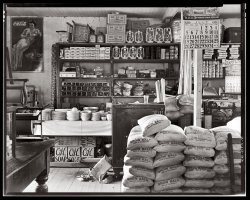
MAY CONTAIN NUTS

Search Shorpy
SHORPY ART

Framed or unframed, desk size to sofa size, printed by us in Arizona and Alabama since 2007. Explore now.
Join and Share
Ad-Free Shorpy
Shorpy is funded by you. Patreon contributors get an ad-free experience.
Learn more.

Recent comments
- Baldwin 62303
- Baldwin VO-1000
- Cold
- No expense spared
- Tough Guys
- Lost in Toyland
- And without gloves
- If I were a blindfolded time traveler
- Smoke Consumer Also Cooks
- Oh that stove!
- Possibly still there?
- What?!?
- $100 Reward
- Freeze Frame
- Texas Flyer wanted
- Just a Year Too Soon
- WWII -- Replacing men with women at the railroad crossing.
- Yes, Icing
- You kids drive me nuts!
- NOT An Easy Job
- I wonder
- Just add window boxes
- Icing Platform?
- Indiana Harbor Belt abides
- Freezing haze
- Corrections (for those who care)
- C&NW at Nelson
- Fallen Flags
- A dangerous job made worse
- Water Stop
Member Photos
The Shorpy
Print Emporium
Print Emporium
Search Shorpy
Search results -- 30 results per page
- Between the Lines: 1935
- ... area. View of Morgantown, West Virginia." 8x10 negative by Walker Evans for the Farm Security Administration. View full size.
Unusual ... Posted by Dave - 12/27/2022 - 11:24am -
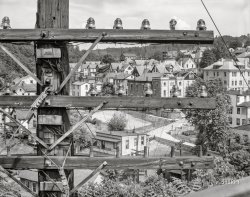
- Here You Go: 1936
- ... Vicinity of Birmingham, Alabama." 8x10 nitrate negative by Walker Evans for the U.S. Resettlement Administration. View full size.
ACROSS ... Posted by Dave - 01/22/2023 - 2:55pm -
![Here You Go: 1936 March 1936. "Steel mill workers' houses, company owned. Vicinity of Birmingham, Alabama." 8x10 nitrate negative by Walker Evans for the U.S. Resettlement Administration. View full size.
ACROSS THE TRACKS.What are those little sheds lining the property? I thought they were outhouses at first, but they are not related to the houses.
[COULD THE TITLE OF THIS POST BE A CLUE? - Dave]
Mystery in the airThe RR electrification is puzzling: there weren't any mainline installations in Alabama, and a plant line would seem like it would present interference with all the loading in a a steel mill; a streetcar line? Power plant line?
[That catenary is over the street, not the RR tracks. - Dave]
OK, but doesn't that just deepen the mystery ?? Birmingham did have trolley buses, but apparently not as early as 1936. Perhaps they're just some kind of power or phone lines, but I'm unclear on why they're suspended.
[The wires are for streetcar service. - Dave]
Ah, so 'Curtain #2': not THE RR track, but still a RR track ... of sorts.
[Those are train tracks. The street is not in the photo -- it's too close to the camera. - Dave]
Gotcha: the curse of 2D!!
Kite-Eating Tree... claims another victim!
Going, going ...Wonder if one of the outhouses had a gas explosion. Looks a little run down.
Random thoughtsThis photo is less than 90 years old; but is unimaginable today for factory housing.
Our house had 2 bedrooms and 1 toilet, if you played by the rules; 6 if you didn't.
That family next door is stealing our Sears & Roebuck!
When it's everybody's business when you do your business.
It's raining; don't tromp mud inside the house when you get back.
At least your sister didn't lock herself in there for an hour.
There you go-- a fine row of jakes.
Something Street ThomasSeveral of these houses remain in Birmingham's Thomas neighborhood. The street railway had a route through here to neighboring Pratt and Ensley that ran to the east of the steam railroad. Not sure exactly which street/alley we're looking down, but we'd most likely be looking west from 16th Avenue Thomas to have the interurban-type overhead wiring (one wire for each direction to simplify signaling) and mast arm in the foreground.
A better Loo for youThey could save themselves a walk to the facilities by just cutting a hole in the kitchen floor. My mumma always said I was a genius.
Outhouse windowsDiamonds in the rough.
Hope they saved their corn cobsOr had plenty of Sears and Montgomery Ward catalogs available.
The Two DoorsEach of these homes has two back doors which leads me to believe that these are actually very tiny duplexes.
Trolley BUSESwere ordered in 1945, so as Notcom says there wouldn't have been double wires for them, but the ones in picture appear to be too close together for bus use. My grandfather was a conductor on the old trolleys prior to 1922, and all the pictures I could find did not have double wires, so? Perhaps someone from Birmingham might have more information. In many cities, street cars were also referred as trolley cars, as the little wheel at the top of the pole which ran against the wire, was a trolley.
[The wires are for streetcar service. - Dave]
Pratt-Ensley streetcarThe streetcar line in question appears to be the #6 Pratt-Ensley route of the Birmingham Electric. At this location the line was single track on a private right-of-way, which helps explain the use of bracket-arm overhead construction with dual contact wire (one for each direction). The route paralleled the steam railway for much of its length. In the background are the Thomas Furnaces of Republic Steel.
(Info from "Street Railways of Birmingham", Hudson & Cox, 1976)
They are DuplexesThere are 8 houses and 16 outhouses.
Neat and humble beginnings Jeffrey Jakucyk, you got the right area! I think it's the houses down to the lower southeast corner of your overhead view. The tiny row houses on 7th Street Thomas and 8th Street. The Evans image just focused on the outhouses but there would have been another row of duplexes just off the left edge of the image.
Life was simple.
(The Gallery, Birmingham, Factories, Railroads, Walker Evans)](https://www.shorpy.com/files/images/SHORPY-8c52171a.thumbnail.jpg)
- Edwards Depot: 1936
- ... Edwards, Mississippi." 8x10 inch nitrate negative by Walker Evans for the U.S. Resettlement Administration. View full size.
...
Without much to go on I believe this is the area in Walker Evans's 1936 photograph. I could not identify any buildings still there ... Posted by Dave - 01/12/2023 - 3:07pm -
![Edwards Depot: 1936 February 1936. "View of railroad station. Edwards, Mississippi." 8x10 inch nitrate negative by Walker Evans for the U.S. Resettlement Administration. View full size.
Vertical LinesWhat are the Vertical Lines suspended from the Horizontal overheads. I suspect a Curtain Array Antenna of some type (?)
[See above. - Dave]
Thanks. Interesting
TelltalesI spot three of them, one over each track.
What a scene.WOW! That's a model railroader's prototype just waiting to be built to scale.
Without much to go onI believe this is the area in Walker Evans's 1936 photograph. I could not identify any buildings still there today. The railroad tracks bear right heading west and are straight heading east.
[W.E. was shooting from the Magnolia Street bridge. The white building with the brick insert is at far left in his photo. - Dave]
Dave, thanks for using a better reference point than I had (I was down by the parked cars at left). Your spot also lets me recommend everyone spin their street view around and appreciate the old homes along Magnolia.
Those "Vertical Lines"As delorthlo states, they are telltales, to warn carmen on the roofs of cars of an approaching tunnel or other obstacle.
Zero stoplights, three pagesIs how someone might have described Edwards in 1936; the "pages" of course being the Sanborn fire maps (In short, a pretty small place; but a step up from one page, and obviously two steps up from not being mapped at all).
The map tells us Edwards seems to have been a more interesting place than it is now: for example the brick buildings beyond the station were but two of a long stretch of such structures -- "Main Street" in both name and fact -- and out of the picture to the right the station fronted on a town square; it doesn't impress much today. One suspects Edwards' opportunity to need a stoplight has passed by.
O' Brother, Where Art Thou.From the crossing looking towards the bridge is from the move O' Brother, Where Art Thou? At the end of the movie this shot is used. Larry is correct, a modeler's dream. On my list to include in my layout.
Both sides of the tracks... look equally bad.
Order BoardThe 2 faced lower quadrant semaphore protruding from the roof of the combined passenger and freight station was not used to control train movements. Instead, it is an "Order Board", controlled by the station agent via vertical rods, used to notify train crews that they needed to pick up train orders, called "flimsies", since they were written on tissue paper to create multiple carbon copies. Depending on the importance of the train order, they could either be picked up on the fly by spearing a thin wooden hoop with your arm, or safety related orders required the crew to stop and sign for the orders. In either case, copies of the orders were delivered to both the engine crew(s) and the conductor in the caboose. The order board indicated which kind of orders they were. A double header with a caboose and pusher would require 4 copies, plus a copy for the agent's records.
Train orders are still used, issued to crews by the dispatcher via radio, with mandatory correct readback from the crew, and the radio traffic recorded in case of an incident. The crew writes the orders on a paper form in the cab.
Those telltales saved lives. In the days before portable "lunchbox" brakeman radios and diesel dynamic brakes, there were several reasons for brakemen to stand on car tops, to signal the engineer while switching around a curve, and to apply and release handbrakes on a downgrade. Incredibly dangerous to keep your balance, and step to the next car, apart from being knocked off the roof by a bridge or tunnel. Eventually, the roof walks were removed, and the ladders leading up to the roof were shortened to just be something to hold on to when riding on the end of a car while switching. Still dangerous work if you aren't alert.
I'm old enough to have seen the tail end of this era, as a kid spent many hours talking with agents in stations and manual "armstrong" interlocking towers, listening to the dispatcher's party line. Knew several crossing watchmen, who spent their days in little towers at major railroad crossings, pumping down the pneumatic crossing gates for each train. I have a small brass 2 lever frame used by the agent to control an order board.
Car IDFive Chevrolets.
TelltalesThese were to warn railroad workers on top of the cars (usually brakemen) that the train was approaching a low overhead structure, in this case the highway overpass from which the photo was taken. As railroad braking systems improved, the need for "decorating" the cars reduced, until the practice is now forbidden.
Phantom StationIn Doug Floor Plan's modern view of the area, it seems that I can see the "ghost" of that long-ago station: lighter patches of grass where buildings used to stand. I guess it's a good example of how quickly human-made constructions can disappear from view and leave no trace, except for some fainter vegetation.
(The Gallery, Railroads, Small Towns, Walker Evans)](https://www.shorpy.com/files/images/SHORPY-8c52107a.thumbnail.jpg)
- Golden Jubilee: 1935
- ... Dallas County, Alabama." 8x10 inch nitrate negative by Walker Evans for the U.S. Resettlement Administration. View full size.
The ... Posted by Dave - 01/21/2023 - 12:19pm -
![Golden Jubilee: 1935 December 1935. "Eagle's Store -- Selma, Dallas County, Alabama." 8x10 inch nitrate negative by Walker Evans for the U.S. Resettlement Administration. View full size.
The little parade on the sidewalkApparently they got tired of people coming in and asking how long they'd been in business.
They've arranged a cute display of kids' vehicles, but I don't know what that thing is at the end (the end opposite the trike). I'm not familiar with that wagon or whatever, with the handles sticking up. Anybody know what it is?
[Two wagons behind two wheelbarrows. - Dave]
Far-traveled titleThe movie showing at the Academy on Friday and Saturday is "The Last Outpost," released in 1935, starring Cary Grant and Claude Rains, and set in Kurdistan during World War I. Still to come: the 1951 film of the same title, starring Ronald Reagan and Rhonda Fleming and set in Arizona during the Civil War. Then in 1987, episode 5 of "Star Trek: The Next Generation," set on Gamma Tauri IV in the 24th century.
1119 Alabama AveCorner of Washington Street. If you do a 360 on Street View, you'll see this section of downtown Selma has seen better days.
The Eagle has landedThe building at 1119 Alabama Avenue still exists. But no more quality is delivered to customers here in the sign of the proud King of the Skies. It's a Super Dollar Store now.
(The Gallery, Small Towns, Stores & Markets, Walker Evans)](https://www.shorpy.com/files/images/SHORPY-8c52070a.thumbnail.jpg)
- Water Avenue: 1935
- ... fire bell tower at right. 8x10 inch nitrate negative by Walker Evans for the U.S. Resettlement Administration. View full size.
... Posted by Dave - 01/14/2023 - 11:37am -
![Water Avenue: 1935 December 1935. "Main street architecture. Selma, Alabama." Premises of the Cotton Exchange and L.C. Adler & Co. furniture store. Note the fire bell tower at right. 8x10 inch nitrate negative by Walker Evans for the U.S. Resettlement Administration. View full size.
FiligreeThe word comes to mind when I look at the fine metalwork of that attractive upper gallery. I know it’s used more with regard to jewelry, but we are allowed to use it when talking about metalwork and wrought iron, too. I also think of lace.
Period architectural detailsIt's interesting to see the quoins (corner blocks/stones) on the brick building. It's hard to see in the shadows, but it looks like arched windows on the second story. The ventilator grilles above each window are an interesting Southern architecture touch. What's not clear to me is the window/door header on the ground floor above the row of doors/windows. There might be arches hidden behind the porch, or this might have a iron/steel beam as a header. If the latter, I'd tend to date this to early 20th century, if the former, then earlier. And if later, the quoins and similar detail along the ground floor doors could be cast concrete, rather than stone. The porch posts are most likely cast iron.
I hope someone has some more history on this building.
Sort of survived
Head bangersThose low hanging light bulbs in the furniture store appear to be ... low hanging. You would think any one of those chairs they're selling would give a person some extra height so they could change a burned out bulb.
Architecture/geography coincidenceWhen I opened Shorpy just now, this was the first image on the top and I said to myself "nice photo of New Orleans French Quarter", then quickly read that it is instead Selma, Alabama. Then, I scrolled down to the next photo, and it's New Orleans! And on top of that, I wouldn't have guessed it by looking.
Still there, maybeIf the recent tornado that ravished the Selma area missed this old building then it is still there.
[You haven't been ravished until you've been ravished by a tornado. - Dave]
Someone stole my balconiesPlease bring them back!
The building (1225 Water Avenue) is still extant, and, up until a few years ago (above) looked little different than in 1935. The most recent Street Views show the ironwork missing. Hopefully they just sent it out to be cleaned.
The historical survey of the building is rather brief: "1223-5 Water Ave. c 1860-70. Italianate. Two-story, two-bay brick two-part commercial block ... Cast iron quoins."
I just knew ...... this was a Walker Evans photograph before reading the caption.
[Taken almost 90 years ago, but digitized and made available online by the Library of Congress only last fall. - Dave]
(The Gallery, Stores & Markets, Walker Evans)](https://www.shorpy.com/files/images/SHORPY-8c52069a.thumbnail.jpg)
- Caffeine Warehouse: 1935
- ... as well as Coca-Cola and Dr. Pepper. Nitrate negative by Walker Evans for the Resettlement Admin. View full size.
Timing Let's see ... Posted by Dave - 01/05/2023 - 3:38pm -
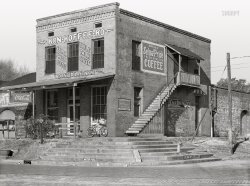
- Sauls Sandwich Shop: 1936
- ... Orleans Parish, Louisiana." 8x10 inch nitrate negative by Walker Evans for the U.S. Resettlement Administration. View full size.
I know ... Posted by Dave - 01/27/2023 - 9:10pm -
![Sauls Sandwich Shop: 1936 January 1936. "New Orleans sandwich shop. Orleans Parish, Louisiana." 8x10 inch nitrate negative by Walker Evans for the U.S. Resettlement Administration. View full size.
I know I'm a dinosaurUnlike kines, I miss cursive and am sad it is no longer taught in schools. For whatever reason it was created, cursive became a very personal part of us. Some have handwriting that is art, some scrawl, but you recognize a person's handwriting the way you will never recognize their printing or texts with emojis. Printing is communication where cursive is conversation. For me, reading letters in cursive is also hearing the writer's voice. Even Sauls' blackboard is a little more inviting than the signage ... that's Sauls talking to you.
EggsWhen I saw the chalkboard I first thought it might be a list of sandwiches. I was hungry. But it's a grocery price list.
Eggs: 25 cents per dozen. That's equal to $5.26 in today's dollars, according to the inflation calculator. Maybe today's "crisis" isn't that bad.
Brands still with usPET [evaporated milk]
Carnation [evaporated milk]
Contadina tomato paste
Luzianne coffee and Tea
Coca-Cola
SignsGood name placement!
Cursed cursiveEven though in my not-so-humble opinion cursive is one of the most inane creations in all of humanity, it is really nice to see it here, adding a distinctly human touch to this otherwise bleak photograph. Said to have been invented to save wear and tear on fragile quill pens, it is now time for cursive to go the way of the carbon arc lamp, typewriter, and the feather quill pen itself.
The original 'saul' food ?I spent my impulse picayunes dining @ N.E. Howe's - or was it N.E Wayze? - but I guess each of us has our own story.
Little circlesAnyone have any idea what those circles on the SANDWICH SHOP letters are?
Long GoneThis is the corner of Prytania and Calliope in the Lower Garden District, just a few blocks from where I first lived in New Orleans. The area is now covered by one of the onramps to the Crescent City Connection bridge over the Mississippi.
Milnut CreamIn 1939 the name was changed to Milnot, a brand that's still around.
Cursive writingis making a sort of comeback, with some schools now starting to teach it again. I agree with Doug Floor Plan that each person's penmanship is an extension of them in some ways. I hope it makes the comeback. Maybe even Spencerian script for some folks. Also, it is just like encryption to some young folks.
Truck ID1928 Ford truck and 1931 Plymouth car
Cursive inclusiveI just want to say, I am fully tolerant and respectful of the opinion of cursive lovers, and I am fully supportive of it being taught as an art form as long as it is not deemed a requirement, or even as being important. And want to share the personal experience that shaped my current opinion. In 8th grade I was doing poorly with cursive and reverted to printing as often as I was allowed. One teacher told me "you might be able to get away with it for now, but you won't be allowed to do this in high school". Then, as if scripted from a movie, my first week in high school I had a teacher tell me how much she loved my printing (which I will also argue is equal to cursive in its recognizability and "extension" of me as a person), and I haven't scrawled a single letter of cursive since. Yet I have had many other compliments on my (non-cursive) penmanship.
Prices Then And NowIn reference to Born Too Late comment: Agree that prices are all relative to the era.
People did not earn $50,000 or $100,000 per year in 1936, as many do now.
Inflation is just an expanding balloon and everything tries to keep up.
Every now and again the balloon goes pop.
Cursive writing styleInteresting comments about cursive script.
I agree with those who say that cursive is an extension of our personality. Each one is different. Some use floral swirls others are more rudimentary and functional. The tightly bound writers reflect a reserved, unimaginative personality, the large bold with swirls attached to many letters would indicate an artistic, creative, open personality.
The manuscripts of earlier centuries contain very impressive examples of script which would have taken a considerable time to write. Japanese calligraphy follows this tradition.
It really is an art form that reflects that we are not machines (yet)
Look at episodes of 'What's My Line' (plenty on Youtube) to see each guest writing their name on a blackboard in beautiful cursive script.
Doctors' cursive is in a world of its own. One might hope that their often undecipherable scrawl (except for pharmacists we assume) is not a reflection of a rushed, chaotic brain.
Cursive is for right-handers onlyCursive is merely artistically stylized sloppy printing where you fail to lift the pen/pencil when you move from letter to letter. It follows the natural movements of a right-handed writer and if rather difficult for a left-hander to emulate.
(The Gallery, New Orleans, Stores & Markets, Walker Evans)](https://www.shorpy.com/files/images/SHORPY-8c52105a.thumbnail.jpg)
- Regular Dinner: 1936
- ... is all it says here. 8x10 inch nitrate negative by Walker Evans for the Farm Security Administration. View full size.
More random ... Posted by Dave - 12/27/2022 - 10:31am -
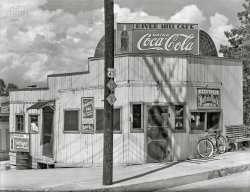
- Easton: 1935
- ... Lehigh River and Canal." 8x10 inch nitrate negative by Walker Evans for the U.S. Resettlement Administration. View full size.
Only ... Posted by Dave - 01/23/2023 - 11:32am -
![Easton: 1935 November 1935. "View of Easton, Pennsylvania, Lehigh River and Canal." 8x10 inch nitrate negative by Walker Evans for the U.S. Resettlement Administration. View full size.
Only one thing.I only know one thing about Easton, Pennsylvania. It was and is the home of "The Easton Assassin," the great Larry Holmes, one of the greatest heavyweight boxing champs of all time. He held the title for around 7 years and took on all comers. Even fought Mike Tyson when he admittedly couldn't beat him. Unfortunately, he also fought a greatly diminished Muhammed Ali, who came back for the money, and he beat Ali so bad even Holmes didn't want the fight to continue. After retiring, Holmes returned to Easton and opened businesses that employed hundreds of people from the area. Maybe he's not "the greatest," but a great son of Easton.
Difficult divine survivalThe distinctive domed towers on the horizon belong to St. Joseph’s Catholic Church, built in 1915. Easton’s Catholic churches served different ethnic enclaves: St. Joseph’s was German.
The church had a difficult future ahead: in 2008 it merged with two other parishes to become Our Lady of Mercy. After 2013, only occasional services were held in the aged building, with what was announced as its final Mass in May 2016. However, in 2018 it reopened as Divine Mercy Healing Center, run by the Vincentian Congregation of the Eastern Rite Catholic Church. It looks good today.
Is that a person under there?Or just some blankets for a person to lie on? The front of the car appears slightly elevated, but the rear tires are not blocked.
The backgroundlooks like it could be a matte painting. What a stunning photograph!!
All of itA classic Shorpy photo with just about all the requisite elements: a steam engine, a jalopy, simple down-to-earth housing, a church, hills, canal and river, laundry on the line (blurred in motion), and a comment that links the small, obscure place to someone famous (Larry Holmes).
"Chief of the Sixes"Was Oakland's official motto when it began producing the first Pontiac Six in 1926.
Sales took off so quickly that a new factory with 35 acres of floor space was erected exclusively for the Pontiac Division of Oakland Motor Car Co. This markedly aged specimen is a Five Passenger Landau Sedan (minus its left landau iron). An automobile wheel and perhaps other car parts are lying in front of it.
Bridging the gapIn addition to Larry Holmes, Easton is known as the home of Crayola crayons. They continue to manufacture them just north of town, and receive large railroad tank cars of the necessary wax on a weekly basis.
Visible in the center is part of the Easton suspension bridge, which when constructed in 1886 was the highest footbridge in the US. It was dropped in 1951.
https://www.bridgemeister.com/pic.php?pid=1431
What is this?It looks like it's the town gallows but I doubt (and hope!) it's not ...
[It looks more decorative than punitive. - Dave]
It's a truckThe wheel in front of the Oakland is still attached to a C cab truck of some sort.
Horse ghost?Any idea what is the blurry image to the right of the telephone pole? I'm guessing a horse in motion?
[People walking. - Dave]
(The Gallery, Railroads, Walker Evans)](https://www.shorpy.com/files/images/SHORPY-8c52082a.thumbnail.jpg)
- George's Place: 1936
- ... Parish, Louisiana." 8x10 inch nitrate negative by Walker Evans for the Resettlement Administration. View full size.
Wish I could ... Posted by Dave - 01/28/2023 - 1:31pm -
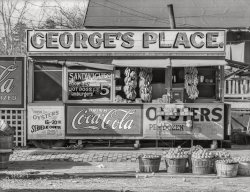
- Rural Mother: 1936
- ... Us Now Praise Famous Men" by James Agee with photos by Walker Evans. Or "The Grapes of Wrath" by John Steinbeck. - Dave]
Not an ... Posted by Ken - 07/05/2009 - 2:29am -
![Rural Mother: 1936 March 1936. "Mother and baby of family of nine living in field on U.S. Route 70 near the Tennessee River." 35mm nitrate negative by Carl Mydans for the Farm Security Administration. View full size.
SonsRose,
And notice that the boy you mention (the one on our right) is the only one wearing shoes. It looks like he's standing on maybe his father's feet--there's somebody else standing off the camera edge.
But imagine: The clothes that they're wearing might've been their only clothes! Just to reiterate: there was no choice of what they could wear from day to day. What they have on now was all they (might've) had for possibly months at a time.
"How do I get to the Susquehanna Hat Company?"
What happened to them?While it's certainly disheartening to see that kind of abject poverty, the family probably fared better over the next decade. The TVA started bringing electricity to that area around the time of this photo and Tennessee had a pretty robust wartime economy. The draft board generally didn't take men with nine children so the father would have been around to find steady work. So however bad it may have been you can at least be confident it got better.
And yet the boy is smilingAnd yet the boy is smiling :)
Mother of povertyThis photo made cry. What more clear image of poverty in America could there be? A flour sack for a skirt and a safety pin holding a tattered sweater. I ache for her children and wonder what happened to this family. One bright spot is the boy smiling to his sister while holding her toe.
Tatters...They may be poor material wise with their tatters and rags on their back, but they are rich in their love for each other.
Mother of povertyThis is the worst case of poverty I have ever seen that wasn't from the third world, but look at them they are together, even able to smile, by far this picture is the best example of "the great depression".
fakeThe picture is of far higher quality than existed in that era. It's obviously a fake.
["That era," the mid-1930s, when photography was 100 years old, saw some of the best photographs ever made - the work of Ansel Adams, for example. And of course a few minutes of Googling will show this to be a well-known Depression-era image in the Library of Congress archives. Comments like these are a good opportunity to point out that the farther back you go, the better and sharper the pictures get, because the recording media were bigger. Two examples are here (1865) and here (1913). As well as here and here and here. - Dave]
Re: No exaggeration"And yeah, glass plate negatives are amazing. But even 35mm film actually carries more information than most digitals: ISO 100 35mm has an effective resolution of 10 megapixels, and when you up the negative size to that of a view camera or the 8x10 glass plates, you're talking resolutions and image quality that today's cameras can't touch."
YOU'RE RIGHT ABOUT THAT !
No exaggerationIn addition to reading "Let us Now Praise Famous Men," check out the photos of Jacob Riis and read "How the Other Half Lives." Yes, muckrakers, but they were not making up the poverty they found and photographed.
When people who were doing *well* had only 2 or 3 sets of clothing, there just wasn't as much "extra" around to give to the poor. Using flour sacks and sugar sacks was incredibly common - so common that it is a trope in literature of the time. Even solidly middle-class families "turned" collars and facings on their clothing when it wore to holes, to use the other side, and every family had a rag bag in which they saved *every* scrap of old clothing for other purposes.
I guess in this day of cheap clothes made by slave laborers in poison-filled factories in China, its hard to believe anyone treated clothes as so precious that they were saved and worn until they were in this state, huh?
And yeah, glass plate negatives are amazing. But even 35mm film actually carries more information than most digitals: ISO 100 35mm has an effective resolution of 10 megapixels, and when you up the negative size to that of a view camera or the 8x10 glass plates, you're talking resolutions and image quality that today's cameras can't touch.
Rural mother 1936Oh how I wish I could take the doubting thomases back with me to the North East of Scotland during the time that this stunning photograph was taken. I am glad that it has been brought up to watchable standard by digital magic or whatever. I can still remember my grandfather filling his boots with straw to keep the cold/wet out before going out to the field to plough or cut corn with a scythe. He also used the very same material to wipe his bottom. Granny had a grain sack for a skirt and wore clogs. My favourite time of day was when she put the 'hen's pot' out to cool. I invariably ate the potatoes and haven't tasted better since. Money-wise it was a very poor time but life had a richness difficult to achieve these days.
Re: Fake>> The picture is of far higher quality than existed in that era. It's obviously a fake.
We get a lot of comments like this, I guess from younger people, or people who have never been to a museum. They don't realize that the farther back you go, the better and sharper professionally taken photographs get, because the recording media were much, much larger. An 8-by-10 glass plate negative is 80 times as large as a 35mm film frame, or the image sensor in a digital camera. Two examples are here (1865) and here (1913). As well as here and here and here. Also a lot of comments from people who seem to think color photography started around 1960.
Poverty exaggerationOk, this photo is an example of early photo-journalism. The family could very well have been homeless and living in a lean-to or a wooden box on top of a truck chassis- during the summer, anyway. But the depiction of poverty is exaggerated- think about it- if someone steered the photographer toward the family, then others in the community knew they were there. There's no way a family can dress like that and not receive donations of used clothes. These rags were put on to evoke sympathy for the plights of many during the depression. Don't get me wrong - shock value was probably needed to raise support for many valuable social programs that came about because of the depression. But how long could a family dress like that and not receive donations from others, no matter how bad off the community was.
[Most of these migrants, refugees from the Dust Bowl farms of the Great Plains, were not especially welcome in the communities where they dropped anchor, and people often did whatever they could to get them to leave. You might want to read up a little more on the Great Depression. A good start would be "Let Us Now Praise Famous Men" by James Agee with photos by Walker Evans. Or "The Grapes of Wrath" by John Steinbeck. - Dave]
Not an exaggeration"There's no way a family can dress like that and not receive donations of used clothes."
My mother was a teenager during those years and remembered how so many people were driven to desperation. Her comment was "there was always someone trying to cheat you."
Two or three years into the Depression the do-gooders began to run out of sympathy and "used clothes." And after five more years of no improvement they began to fear things would never turn around and that they would end up in the same circumstances.
There were just too many newly poor people and not enough people with excess resources to balance things out.
BenIf anyone was ever interested in trying to achieve that kind of detail today, I'd highly suggest buying an old used medium format camera and using some 120 roll film. I have a couple of Yashica TLR's which were considered substandard in the 50's and 60's, but their quality still makes a 35 SLR look like a cheap point and shoot. It's not the camera that makes the pictures better, but the larger negative available in 120 film. Not only do you get more detail, but the color depth is far more realistic.
ClothesMy Gramma has saved some clothes that her mother made from flour sacks. She also has some made from linen and wool they spun and wove themselves, when they were more prosperous.
She lived in a house with a dirt floor and didn't wear shoes in the summer.
The Face of the Great DepressionThank you Mr. Caruso.
I echo the response from Dave....We read in history books about the Great Depression and over the years, in our mind it is simply a swirl of facts and figures, of almost dispassionate removal that was the reality. While it has been said that hindsight is 20/20, I think it can also be argued that hindsight, especially from such a distance can be sterile becoming almost become an illusion, an event without a substance.
Hopefully this will once again place it into a reality ...
http://www.youtube.com/watch?v=FSShPnOS15Y
Dale
Oh My GoshI'm 15 years of age and I had no idea that the Great Depression was that bad. This picture really oppened my eyes to the extreme conditions at that time. Thank you for this reality.
Reality CheckI have a picture on my desk showing my mother during the depression. You can see her bones because at 5'7" she weighed 85 pounds...just from the simple lack of food. Each girl in the family had two dresses and each boy had two pairs of overalls - one to wear and one to wash. By "wash", I mean using a metal tub over an open fire. Mostly they went barefoot (in the Arizona desert) because if they had shoes, they were too valuable to wear everyday. In the picture my mother is looking directly at the camera and her expression is almost exactly the same as the look on the face of a shell shocked combat veteran.
As I said, I keep this small black and white photo on my desk so that if I ever, ever have even a moment of thinking that I'm having a hard day I can look at my mother's face and get a reality check.
Barefoot KidsMy parents grew up in the depression. When I was a kid (in the 60s) going outside barefoot was STRICTLY FORBIDDEN, reason being that in their minds if you weren't wearing shoes it was because you didn't have any, and therefore were poor, which they viewed as something to be ashamed of.
Making doThe habits of the depression generation persisted into the better days of the '40s. I remember my mother repairing worn sheets by splitting them down the middle and sewing the good edges together to prolong their life. My dad brought home flour sacks from the restaurant where he worked. My mother made dish cloths and pillow cases from them. Some of the sacks were made from patterned material for dresses. The branding on the others washed out easily. To this day I an reluctant to discard clothing.
ClothesMy parents did not allow us to wear jeans (which we didn't own) or sneakers because they weren't real clothing, but only worn if you owned nothing else. Believe me we weren't rich either.
Mother of NineThank you so much for sharing this. I was born in 1977, but just hearing these stories helps me to realize that we are so spoiled and really puts things into perspective.
Amen! Thanks, dalecaruso!I'm going to show this to my 7th grade students who LOVED the Newbery Medal-winning book "Out of the Dust" by Karen Hesse!
Amazing...moving...thank you.
The habits remained - for good or badMy parents grew up in the Depression. Members of their generation, roughly those born 1920-1935, often find it difficult to throw out anything "good". In my parents' case, I was left with stacks of thousands upon thousands of moldering magazines and newspapers, piles of old shingles, 2x4s, chunks of vinyl siding, and old cardboard; hundreds upon hundreds of doilies, knick-knacks, and figurines; and tons of worthless, useless plywood and cheap wood furniture. The cry was, "I might need it someday!" and "It'll be worth GOOD MONEY one day!" and "You're so wicked and wasteful and lazy to want to throw it out!".
They were wrong in every single solitary instance, no exceptions. The figurines now go for five to ten cents each on eBay (and don't sell at that price); the shingles melted together into a big unusable pile; the 2x4s and cardboard rotted to dust; the doilies were attacked with mold; the magazines were destroyed by water and age; the furniture was rickety and undesirable in its shoddy construction and unattractive, unmarketable poor style. It all went away to the dump as useless, worthless, unrecyclable (because of the mold) garbage - and it cost over a thousand dollars to have it hauled away.
And I'm not the only one. There are internet groups made up of people in their 40s and 50s who are, like me, dealing with the unhealthy hoarding habits of their Depression-era parents who have passed on.
But we, the children, are not the ones hurt the most by this sickness. The older generation itself is harmed most of all. The mold and dust gathered by the things they've hoarded endangers their health. The sheer bulk of the hoard can endanger them in case of fire. And since they can't find what they've hoarded, they end up buying the same things over and over again, which reduces their ability to provide for themselves.
No North American generation before this one has suffered from this level of hoarding, and I doubt any one after it will. Earlier generations didn't overbuy but also weren't afraid to discard; later generations might overbuy but likewise aren't afraid to recycle or discard.
Re: Hoarders I would have to seriously question the sweeping and wide swath of the brush you painted this generation with. My parents lived through the depression and the dust bowl, as did my dads' 12 brothers and sisters. and the 5 siblings of my mothers' family.
And not a hoarder among them.
I am sure they used things longer and valued what they had more than we do, but I hardly consider this a "disorder".
Now I am sure some did, but your statement to me really portrays this generation as unhealthy mentally, and I am just a little offended by it. Oh that we today were as mentally stable as they.
And if "There are internet groups made up of people in their 40s and 50s who are, like me, dealing with the unhealthy hoarding habits of their Depression-era parents who have passed on", well then I would say, perhaps it is this weak-kneed generation, who need support groups because, "Oh No, Mamma kept things a Long Long time", are the ones who are unhealthy.
You do this unbelievable generation a great disservice.
Future Hoarders of America Unite!You know, I don't look at the faces of these little ones and concern myself with the idea that their biggest issue in their senior years is going to be that they held on to too much stuff instead of throwing it out. When your clothes are being held together with twine and your mother is wearing a cotton feed bag as a skirt, it's kind of easy to see how, in the future, when you're an old woman, you're probably going to hang on to every scrap and see its potential usefulness someday.
It's amazing how differently our consumerist culture sees items today. How often I've longed to be able to hold onto a toaster that could work just fine if I had someone who could fix it for me. But instead, appliances today aren't meant to last for more than a few years and then off to dump with them. Our landfills are overcrowded with plasticized items that will never, ever decompose - plastic bags, water bottles, take out containers...the list is endless. I hate to politicize a picture but I can honestly see how having nothing more than the holey shirt on your back would make you take stock when one day you had tremendous bounty. We could learn a lot from these people and their troubles and how to see potential treasure in trash.
Alive and wellPoverty can be because of chance or personal choices. Back in the times of the Depression it was heaped on people by powers out of their control. I see it today right here in Arkansas where I live and in my own neighborhood. I live in a small town of about 5600 and even in what is supposedly the world's most rich and powerful country people are lining up at the free food banks and food giveaways, receving government commodities and waiting in ine at the free medical clinic that is run by area churches and staffed with Doctors and Nurses who volunteer their time for free. Just walk into Walmart on the 1st of the month, they way some families are dressed would break your heart.
But then you have the victims of bad personal choices. There is a single other in my neighborhood that recently lost her job because she failed a drug test. She has 3 children. Everyone in the neighborhood knows she sells her food stamps for alcohol. She would buy just enough (barely) food for them to get by and sell the rest If it were not for the kindness of neighbors her children would not have any decent clothes. She was just kicked out of what is very decent public housing where she was paying $16.00 a month rent because she had her alcoholic boyfriend living there with her. Her poor choices affected not only her children but many people in the neighborhood (who at their own expense would buy extra food so they could feed her children or spend money to buy clothes for them) who have tried to help her for years.
In her children I see the NEXT generation of American poverty waiting to happen and it is so sad.
HoardersMy parents are children of the Depression, too. And my father most definitely instilled in me the sense that one doesn't waste or discard anything useful. He has 2 barns and a shed filled with stuff, much of which I'll have to deal with after he's gone.
But you know what? Virtually everything he has is valuable! His shed is filled with dishes and small appliances and the like, which has supplied many of his grandchildren when they went away to college or got their first apartment. He has one of nearly every tool known to man, and freely loans or gives them away. He paid cash for a brand new truck recently, using the proceeds from sale of scrap copper and iron he's been saving in the plum thicket. (He's never owed money on a car in my lifetime).
He loves to give to others (it's nearly impossible to leave a visit empty-handed), and a lifetime of saving and storing means he has no shortage of things to give away.
Because of my upbringing, it's very hard for me to discard anything that still has value, just because I don't need it any more. But I've learned from my dad - somebody needs that, so give it away!
I understand that some hoarders are truly mentally ill. But to say that all Depression children who refuse to discard things that might be useful are "wrong in every single solitary instance, no exceptions" is absolute hogwash.
The DepressionAnyone who says these photos are exaggerated or fake has never talked to someone who lived during that time. My mother lived on a farm during that period, and though she didn't have much that came from a store, they were able to eat and eat well. My father's family were poor tennant farmers on unproductive land and frequently had meals like "grease smeared on bread"....try to imagine that one. With several children, all but one had to quit school at 13 to earn a living. My husband's family has pictures of the children looking just like these - torn overalls and bare feet. Do some real research in your own family's past.
Family HistoryMy father's family had a farm in southwest Nebraska during the Depression, so they were able to grow their own food and eat fairly well. My mother's paternal grandfather was a Methodist minister there, which was very rough since he was dependent on what the local community could pay, which wasn't much and people had an odd idea about what made a suitable gift. So instead of eggs and chickens, which Great-Grandpa would have taken in a heartbeat (he had 5 teenage sons!), people gave him things like fancy hankies, which he had no use for, and I found 50 years later still in the gift boxes. I know the Depression had a profound impact on my grandfather; he hated to throw anything away. When my mother cleaned out Grandpa's house in the late 80's she had to throw out dumpsters of metal pie plates, shopping bags, twine, bottles, newspapers, magazines and God knows what else.
AgreedMy parents did not allow us to wear jeans (which we didn't own) or sneakers because they weren't real clothing, but only worn if you owned nothing else. Believe me we weren't rich either.
I would have said this if you didn't. We had sneakers for gym class and gym class only.
The picture, the video, the hoarding.Two things struck me about that picture: the caked on dirt on the mother's feet and the smile on the boy's face. Sure, I had heard the phrase "dressed in flour sacks." But, there's something about an image - seeing it. It hits home.
The video, The Face of the Great Depression, http://www.youtube.com/watch?v=FSShPnOS15Y from a previous comment. At first, honestly, I thought, "Can't the pictures move faster?" Then I looked, and listened, and let time stand still for a brief moment. By the end, I was crying. The license plate in the last photo was 1939. My mother would have been 13.
NOW IT GET IT. Well, I'm beginning to. A second generation child on the South Side of Chicago, she always told stories of a her gang of kids distracting the cart owner so other kids could run by - stealing whatever vegetables they could grab. They would start little fires at the curb and roast them on a stick or boil them in a pot of water. She said that's why, as an adult, she hated boiled onions or potatoes. But, the stories she told, of washing out her underclothes each night, sleeping 4 to a bed, lard and bread sandwiches...I somehow cleaned up the images and made them all pretty. I left out what it smells like if you haven't had a bath. Or, what it must have felt like to really, really be hungry.
Mom hoarded. Born in 1926 she left me the legacy of wall to wall, floor to ceiling piles of National Geographic magazines and "collectors" tins." "These will be worth something someday," she chided...and promised. They weren't. Well, some of it was valuable - more from memories of her than replacement cost. More than anything, I wish she could have culled her stuff so she had more room to live. Sure, it was a burden to empty. But it was easier for me to let go of her junk than it was for her to unload the fear of being "without." I can live with that. Everyday I understand and accept her more.
One little photo...
Can teach so much.
The Great DepressionI've read the comments about this picture and echo the feelings of distress that people have had to exist under these conditions. We only have to look at some of the present day third world countries to see the same thing. Thank God that that level of poverty has never touched me. I was born in 1927 and raised, with my sister, in a single parent home. My Mother took in washing and ironing to make a living for us, and though we didn't have an abundance, we never went to bed hungry. She bought used adult clothes and cut them down to fit us (our sunday school and church clothes). No one told me that times were hard so I didn't know it until I was grown. The hobos (Hoover Tourists) used to get off the trains near our house and come to the door begging food. My Mother always made them a peanut butter sandwich. I spent my days in school or outside playing with my friends, I had a glorious childhood. It pains me to see today's children confined to the house, afraid to go outside alone, with only a TV or computer for a companion. So many children and young adults are overweight and under exercised. The Depression was hard on a lot of people but, as a child, I skated through it and wouldn't trade my childhood memories for being a child today.
Where in SW Nebraska?Hello-
A friend of mine introduced me to this website. I, too, am from southwest Nebraska. Where in SW Nebraska was your family originally from?
MJ
The DepressionI really liked reading all the comments. I intend to get the book "Let Us Now Praise Famous Men" by Agee. I was born in 1921, the seventh child in a family of 10. My father died of TB in October 1929.
Our church had a dinner after the service yesterday. I noticed some people not eating all the food they had put on their plates. I told them my clean plate was a reflection of living through the Depression, when at mealtime I would hand my plate to my mother with the words "All I can have. please."
Every child in the family, when they were old enough, gave most of the money they earned to our mother. In the early 1930s our school clothes and shoes would be ordered by mail from Sears and sometime they would arrive days after school started. We lived in northwest Detroit and most of the kids had fathers with good jobs.
In 1936 my oldest brother started to build a home near Mount Clemens, Michigan. A family pitched a tent in a field across the street from him and lived much like the family in this picture. My brother did not want me to visit them.
I served in WW2, which I enjoyed because I had been working since I was 14 and it was nice to be free of responsibility. And seeing Europe was wonderful. I am a tourist at heart. Yes! Not getting killed and living into the Internet age is wonderful.
Nebraska! With family now on the West Coast in Oregon and Washington we have been driving across this country about once a year. We like Nebraska and have been driving across that state on old U.S. 30, and find it much more enjoyable than I-80. Please try this some time.
For those who don't believeRead "The Worst Hard Time" by Tim Egan. Never had heard of "dust pneumonia" until reading this. Also, a section of diary entries is just heartbreaking. Poverty and desolation on a scale unimaginable today.
(The Gallery, Carl Mydans, Great Depression, Rural America)](https://www.shorpy.com/files/images/8a01636u.thumbnail.jpg)
- Love Before Breakfast: 1936
- ... in Atlanta. March 1936 View full size. Photograph by Walker Evans.
Looks like Cabbagetown From the building and smokestack that you ... Posted by Dave - 08/20/2012 - 1:06am -
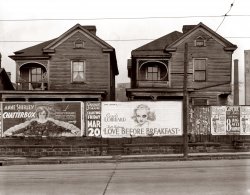
- The Summer of ’36
- ... cabin. View full size. 35mm nitrate negative by Walker Evans.
Is it propaganda somewhat? I know these people were as poor as ... Posted by Dave - 09/08/2011 - 8:51pm -
![The Summer of ’36 Summer 1936. Children of sharecropper Frank Tengle at their Hale County, Alabama, cabin. View full size. 35mm nitrate negative by Walker Evans.
Is it propaganda somewhat?I know these people were as poor as they appear, but I do have a feeling the photographer wanted their worst clothes on, don't you? I mean the way she appears to be brushing her hair, and the other lady seems to be adjusting her rags, it just seems so staged. But don't get me wrong, my own mother and father lived this at this very time in Oklahoma, with dust to boot. I know it is real.
[The Tengle family, along with their neighbors the Fieldses and the Burroughses, were the subject of the book "Let Us Now Praise Famous Men" by James Agee and Walker Evans, probably the most famous photoessay the 20th century. You might want to give it a read. This picture, one of the photographs in the book, is in the archives of the Library of Congress. - Dave]
DisagreeAccording to James Agee, Evans allowed the mothers to clean up their children, if they desired, before he photographed them. Candid shots were not to be achieved at the cost of shaming the families beyond the shame they already felt
ComparisonI am African-American, born around this time and lived in the South. We were not affluent by any means, but we were never this poor. I attribute this to the luck of being in a more prosperous city with a never-failing industry (tobacco) where there was always employment available.
Comparison IIMy dad is from the South about this time and this was still in the Depression. He said he was lucky to have one pair of shoes a year and they didn't wear them except to go to school or something. My Dad talked about finding a five dollar bill and it was a joyous occasion. That money bought all three kids (him and two brothers) clothes and shoes for the year. It was a sad time when people were doing without and doing the best they could.
LUNPFM"Let Us Now Praise Famous Men" may be the most famous photo-essay book of the 20th century today but it certainly wasn't in its time. If I recall correctly it sold only a few hundred copies. Neither Agee nor Evans had achieved the fame they later achieved at the time of the book.
Same as todayuneducated, stupid, selfish people having children they cant feed or cloth properly.. b/c wasnt invented , i know but there was abstinence.
[I wonder if they were so moronic that they couldn't spell "clothe." - Dave]
Life as a SharecropperThis photo brings my parents' childhood to life for me. Both are children of Alabama sharecroppers, and became sharecroppers also. My father attended school until the 2nd grade, and then worked in the fields until he was drafted for WWII at the age of 18. Girls often attended school, since many of the girls could not perform as well in the fields. Many times the children did not have shoes. Animals could go through the house at will. Clothes were made from croker sacks. Fruit was the usual holiday gift for children. Meat was not common at meals. Families attempted to raise and store produce to make it through the year. One of my grandmothers was physically handicapped and raised three children in this environment. Many fathers were alcoholics and spent what little money they came across on booze. After WWII, my parents left Alabama for good with little more than a single suitcase. My father, having learned to read and write in the Army, led a very successful life. My generation was the first to be born in hospitals and graduate from high school. This photograph does not exaggerate the life of a sharecropper's family during the 30's in Alabama.
(The Gallery, Great Depression, Rural America, Walker Evans)](https://www.shorpy.com/files/images/8a44437u.thumbnail.jpg)
- Selma, Alabama: 1935
- ... scene in Selma, Alabama." 8x10 inch nitrate negative by Walker Evans for the Resettlement Administration. View full size.
silas green ... Posted by Dave - 05/14/2019 - 10:27am -
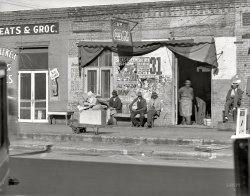
- Wild Animal Circus: 1936
- ... near Lynchburg, South Carolina. 35mm nitrate negative by Walker Evans for the Farm Security Administration. View full size.
Cole Bros ... Posted by Dave - 12/27/2007 - 8:53pm -
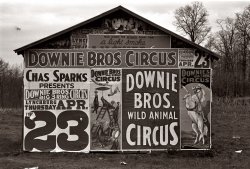
- Crossroads Store: 1936
- ... Last glimpsed here . 8x10 inch acetate negative by Walker Evans for the U.S. Resettlement Administration. View full size.
in need ... Posted by Dave - 12/28/2022 - 12:16pm -
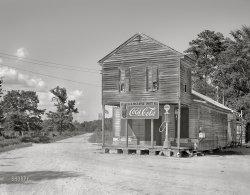
- Greensboro, Alabama: 1936
- ... Hale County, Alabama," in August 1936 as photographed by Walker Evans. View full size. The McCollum Grocery on the corner is the subject of ... Posted by Dave - 08/03/2012 - 11:35am -
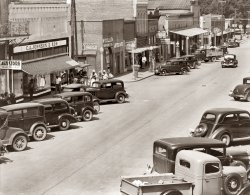
- Cafe Kelly: 1936
- ... street storefronts." Large-format nitrate negative by Walker Evans for the Farm Security Administration. View full size.
Do Drop ... Posted by Dave - 06/09/2010 - 10:48am -
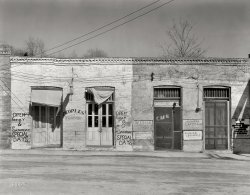
- New Deal: 1936
- ... barbershop seen in the previous post. Nitrate negative by Walker Evans for the Resettlement Administration. View full size.
Hey, ... Posted by Dave - 09/12/2011 - 4:56pm -
![New Deal: 1936 March 1936. Vicksburg, Mississippi. "Vicksburg Negroes and shop front." A close-up of the New Deal barbershop seen in the previous post. Nitrate negative by Walker Evans for the Resettlement Administration. View full size.
Hey, Brother, Can You Spare a Doorknob?They just have to depend on a latch to lock up. This is a picture of poverty.
Vicksburg Negroeswould be a great name for a punk band
Bang bang bang bangThere must be thousands of nails in the top section of siding. I wonder why.
No shave, but a haircut...Two bits!
Billboard & Banner AdsThe nails are probably from hanging billboard and banner ads.
Top SidingUsed to be a big sign that said "Post No Bills"!
A line in the sand, I mean the sidingAs long as you don't cross this line we will be fine...
Striking Figure!Man on right resembles Muhammad Ali when in his prime!
[Maybe the Clay in Clay & Rembert was related to Cassius. - Dave]
Cassius ClayCassius Clay was from Louisville, as was his namesake. Cassius Marcellus Clay was a cousin of Henry Clay, an ardent pro Union man, and an abolitionist.
He dispatched more than one adversary with his trusty Bowie knife. I think he would be very proud of the man who later bore his name, even if he did later change it to Muhammad Ali.
(The Gallery, Small Towns, Stores & Markets, Vicksburg, Walker Evans)](https://www.shorpy.com/files/images/8c52208u1.thumbnail.jpg)
- Junkscape: 1935
- ... Easton, Pennsylvania." Large-format nitrate negative by Walker Evans for the Farm Security Administration. View full size.
Uncle ... Posted by Dave - 03/13/2009 - 11:29am -
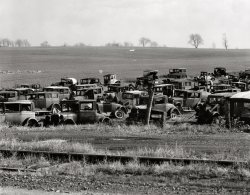
- Vicksburg: 1936
- ... Vicksburg, Mississippi." Large-format nitrate negative by Walker Evans for the Farm Security Administration. View full size.
Moorish in ... Posted by Dave - 09/12/2011 - 7:11pm -
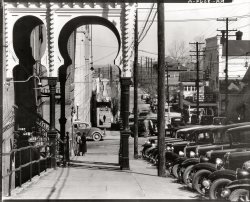
- Sloss Benzol: 1935
- ... houses near Birmingham." 8x10 inch nitrate negative by Walker Evans for the Resettlement Administration. View full size.
A jaunty ... Posted by Dave - 09/02/2019 - 6:16pm -
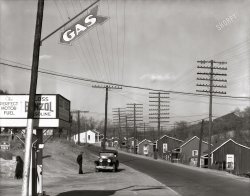
- Gingerbread House: 1936
- ... Waveland, Mississippi." Large-format nitrate negative by Walker Evans for the Farm Security Administration. View full size.
Monkeys on ... Posted by Dave - 09/05/2012 - 6:05pm -
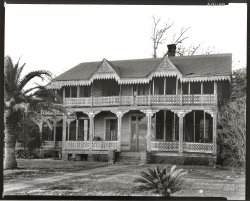
- Cherokee Parts: 1936
- ... shop. Atlanta, Georgia." Large-format nitrate negative by Walker Evans for the Farm Security Administration. View full size.
Modern Day ... Posted by Dave - 07/22/2012 - 2:43pm -
![Cherokee Parts: 1936 March 1936. "Auto parts shop. Atlanta, Georgia." Large-format nitrate negative by Walker Evans for the Farm Security Administration. View full size.
Modern Day WheelThe wheel directly below the "A" and "R" of "garage" looks like it could easily be used on one of today's cars.
Sure Beat UpThis truck appears to be a 1928-29 Ford cobbled out of something else. The rear of the cab isn't from a stock pickup. Really beat up for a vehicle 7-8 years old. And those Model A's were built like a tank. It's had a rough life.
InvitingOh, imagine opening the place up and starting work by hanging all those car parts up. And then imagine the passing punters: "that looks nice, especially that fender there - I think I'll have them do my car right away!".
Mystery MetalI can't for the life of me figure out where that large apparent body part hanging under the word "Used" would go on a car. Anyone know?
[Front right fender. - Dave]
Ah, OK, we're seeing it from the top, then, and it's a lot deeper than it looks here. Thanks.
Greatest HitsThis photo was the inspiration for the cover art on the album "Alice Cooper's Greatest Hits."
Whoa!, that font!Is it just me or does that beautiful lettering scream Jazz Age!! ?
From cars to packing machinesCherokee Parts Store was at 973 Marietta Street in Atlanta. That location is now home to a packing machine company.
View Larger Map
re: Greatest HitsInteresting - apparently, Drew Struzan drew the "Greatest Hits" artwork with the band surrounded by iconic stars. The original included 13 stars who were still alive, which presented a problem, so they had to re-do it without those individuals. A related piece doesn't really resemble the garage in Evans' photograph, but does include the name:
Quite the place back in the dayIt seems that this place was a real chick magnet at the time.
Re Modern day wheelIn fact, my eyes double-took when I saw that wheel, which is not too different from the ones on my E-Class MB. And, boy, they did have a lot of merchandise to hang outside while their morning coffees were cooling, didn't they?
Is that you, Jack?Probably not, but the young guy inside the garage sure looks like a young Kerouac. 'Course Kerouac lived in Massachusetts then. The young lady on the far left seems to have noticed something--maybe the guy--in spite of her disgust at having to be there at that smelly old garage while her mother gets new tires.
'29 Ford roadster pickupThat's a 1928 or '29 Ford Model A roadster pickup, looking mostly original except for the wheels and the absence of its top, doors and spare tire. The fabric top was removable, but not foldable, and the car had no side windows, only side curtains that clipped onto the doors and windshield.
Font NameTo JeffK: although the sign appears to be hand painted, the font that inspired the lettering is "Windsor." The sign painter did not copy the typeface with 100 per cent accuracy, but after 40 years in the graphic design business, I'd say Windsor!
Just down the streetThis is just down the street where my dad (a mechanic) grew up. He probably visited the shop many times.
AirwheelsThat Model A is wearing a pair of aftermarket low-pressure tires on the rear, also known as Jumbos, the tire and rim combination were offered by several tire companies and claimed improved ride and handling over the narrower high-pressure stock units.
Those wheels are rarely seen on restored vehicles today because those special sizes haven't been reproduced, modern tires will fit on them so they do see some use by traditional hot-rod builders.
Wheels,etc.The large part hanging under the used sign is a fender as mentioned in an earlier post. It is from a 1930/31 Ford.
I would love to see under the hood. I would bet money it has a Flathead V8 in it. The front wheels are off of a 32 or later which means they have probably changed from mechanical brakes to hydraulic and the rear wheels look the GM "Artillery" wheels used on later 30's GM cars. The wheel hanging on the wall behind the woman is a stock 29/31 model A wheel. I think this may be the shops hot rod parts truck.
NASCAR ConnectionAbout 13 years after this picture was taken, Cherokee Auto Parts began sponsoring Gober Sosebee in the earliest years of NASCAR. Both his #50 and #51 cars carried the name on their doors. He had 2 wins, 4 poles, and 33 top tens in a 71 race career.
(The Gallery, Atlanta, Cars, Trucks, Buses, Walker Evans)](https://www.shorpy.com/files/images/SHORPY_8c52233u.thumbnail.jpg)
- Sun Coffee Shop: 1935
- ... street." North Front at Canal. Nitrate negative by Walker Evans for the Farm Security Administration. View full size.
... country.
(The Gallery, Eateries & Bars, New Orleans, Walker Evans) ... Posted by Dave - 07/19/2012 - 4:35pm -
![Sun Coffee Shop: 1935 December 1935. "New Orleans, downtown street." North Front at Canal. Nitrate negative by Walker Evans for the Farm Security Administration. View full size.
Untrustworthy LaundryAnother wonderful Shorpy picture packed with detail! I'm curious about the laundry sign in the centre of the the picture; they are advertising that they are "Not in the trust." Can anyone shed light on what this phrase refers to?
[It means the business is not part of a price-fixing cartel. - Dave]
French DripNot to be confused with French Press. The French Drip coffee maker consists of a pot from which you serve and the top part which contains the coffee grounds. Pour the hot water into the top portion and allow the water to drop through the grounds infusing the flavour into the water. continue to add water until the desired amount of coffee is made. Similar to the way that most coffee makers today operate, but when you realize that in the day most coffee was either percolated or served out of those big urns you can see why they advertised the more labour intensive (but better tasting) process.
Chinese LaundryChinese Laundries were ubiquitous in most cities. There was one in our neighbourhood when I was a kid but it closed in the very late 60s.
The building is still there but I doubt that the people who live in the remodelled and upscale building know its history.
I can still remember the tubs sitting outside the building at the back that was the actual wash-house, also turned into a pied-a-terre.
The photo was taken before its latest refurb.
Bohn Ford still thereOne of the Fords in the foreground has "BOHN" on the spare tire cover. Bohn Ford (now Don Bohn Ford) is still there, located on the West Bank in Harvey. In the '70s they were Dick Bohn Ford (no snide remarks, please).
Also, it looks to me like the sign for the cross street is Canal. Today that's where the Harrah's casino is located.
The City That Never SleepsNew Orleans looks to be one well-caffeinated town!
LuzianneI actually drink Luzianne coffee, but I didn't know the brand was that old.
Getting your message acrossThe lengths they've gone to, extending so many signs closer to the street and car traffic, it seems. I imagine the first business to extend their sign outwards by about 10-15 feet caused the many others to do the same. Looks like the Oriental Laundry is ahead right now.
Dang!`Wish that pedestrian wasn't blocking our view of the menu board.
Also, wonder when New Orleans got the tri-color traffic signals.
All goneThe city of my birth and it probably didn't look much different in 1948 when I made my appearance. Canal Street and North Front don't meet up today; Saks Fifth Avenue is on this corner and Harrah's Casino is across the street.
At 921 Canal St was the wonderful New Orleans department store Maison Blanche where we would go for photos with Santa and his sidekick Mr Bingle. Today it's the Ritz Carlton. I have to find one of our Santa photos.
Arthur Brisbane was one of the most important newspapermen of the early 20th century and worked for Hearst, but would die a year after this photo was taken. The Daily States would disappear by 1962 in a newspaper merger.
BangAnd how often today do you see a huge "FIREWORKS" sign?
[Well, if you live down South ... - Dave]
Barq's has biteBarq's Root Beer on the chalk sidewalk sign, didn't know Barq's was that old.
Signs on signs.Interesting in that some of the poles carrying the advertising signs have smaller signs advertising the fact that they maintain the signs!
Jax Beer signNot to mention the more picturesque neon Regal Beer sign.
Jax and Barq'sI find it interesting that the tradition of being able to get a beer anywhere in New Orleans stretches back as far as anyone can remember, which is very much uncommon in the rest of the South. Does anyone else see the partially hidden Jax Beer sign?
I also like that the Barq's Root Beer logo hasn't changed in 75 years, in those days Barq's was a Southern Mississippi and South Louisiana beverage with the Biloxi, New Orleans, and Baton Rogue bottlers each having slightly different syrup formulas. Sadly, I'm too young to have experienced the old Third Coast.
Very exoticWhat, I wonder, is "French Drip Coffee"?
French DripCoffee made in a two-part pot. The bottom has a spout and handle and it is capped with a small pot with a lid.... You put the coffee in the top pot and and boiling water is poured over the grounds. They then drop down into the bottom pot. It is/was the favoured coffee in Louisiana.
Pots were hard to get for a long time but the popularity is again on the upswing and there are pots again being made.
Here is a poem about making the coffee...
http://frenchdrip.com/_wsn/page3.html
Popular Among the PoorOftentimes in the South of antiquity, and I suppose the process was developed during the Civil War as a result of the Union blockade, a substitute for coffee was chicory. A brew from it would be syrupy, bitter, and quite strong, but sometimes ya gotta do what'cha gotta do. Chicory coffee is still popular today in some areas of the South.
I Love This SiteThanks for this wonderful photo. I grew up in Metairie, 20 mins from New Orleans - but really I'm from that sweet old city New Orleans. This photo along with the others on this site are inspiring me to do a painting. Thank you so much!
Re: "Oriental" LaundryIn 1959-60 I lived in New Orleans, on St. Charles street, between Canal and Lee Circle, maybe 6-7 blocks from the Sun Coffee Shop corner shown above. My then employment required white dress shirts. One block down St. Charles and across the street from me was what I called a Chinese laundry. I would leave my shirts and get them back wrapped in a brown paper package tied with white string.
In the 1990s I saw the play "Driving Miss Daisy." I was astounded to see, as a prop, laundry returned in brown paper tied with white string. Until then I'd never realized that was probably a common practice.
I lived about two blocks toward Lee Circle from the Liberty Theatre. https://www.shorpy.com/node/5786 The Liberty and another theatre close by were still open when I was there.
The Dream FactoryThe above New Orleans "Sun Coffee Shop" photo is shown in "Hollywood: The Dream Factory" (TV 1972). It's meant to show a scene of the 1930s depression. It immediately follows a "Hollywood Party" with women dancing, literally, on tables.
It's at 2:35+ in this YouTube video: https://www.youtube.com/watch?v=83cqJPwlvQA
===
Happy New Year, Shorpy, Dave, and all!
Chinese Hand LaundriesMy Father the Laundryman, always complained about the Chinese Hand Laundries in NYC. He once said to me that he was convinced that Chinese Government subsidized those businesses so they were able to undercut the pricing of the regular (White) owned shops. They really weren't his competition because they couldn't afford the rents on the Upper West Side of Manhattan. The reason they could do it so cheaply was, simply that the overhead was much lower. Their shops were in mainly in less affluent residential areas. The usually lived in or above the store and employed no help. The entire family worked, the husband marked the incoming wash, with those indelible ink characters, used to identify the customer, found usually on the inside of the article to be laundered. The pair after laundering the clothes then ironed them. The children did other tasks including pick up and delivery. All meals were taken on the premises. They never got rich but the children all went to the public school and many continued to High School. I think most of us are familiar with the 3rd generation and their accomplishments in this country.
(The Gallery, Eateries & Bars, New Orleans, Walker Evans)](https://www.shorpy.com/files/images/8c52104u.thumbnail.jpg)
- Shine: 1936
- ... stand, Southeastern U.S., 1936. (Title and date from Walker Evans, 1973. No caption for this image in FSA/OWI shelflist.)" Who will be the ... Posted by Dave - 08/13/2013 - 4:10pm -
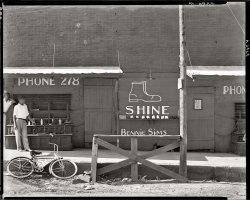
- Cracker Barrel: 1936
- ... Vicinity of Selma, Alabama." 8x10 nitrate negative by Walker Evans for the Farm Security Administration. View full size.
Prince ... Posted by Dave - 06/02/2011 - 1:43am -
![Cracker Barrel: 1936 January 1936. "Store with false front. Vicinity of Selma, Alabama." 8x10 nitrate negative by Walker Evans for the Farm Security Administration. View full size.
Prince AlbertWell, there's one question nobody will have to ask.
Got Nails?I don't think they used enough nails to attach the batons.
["Battens." - Dave]
Prince Albert in a canYou better let him out before he smothers. Right tterrace?
Lucky Strike Green Has Gone To WarThe signs on the walls were predominately for tobacco products. Lucky Strike cigarettes, then in a green package which became white at the beginning of WW2 because the copper used in making the ink was needed for the war effort. The pipe tobacco brands "George Washington" and the famous canned "Prince Albert" were both products of the RJ Reynolds Tobacco Company. The brand "Stud" was a tobacco product, used if you rolled your own or, I guess, chewed.
(The Gallery, Stores & Markets, Walker Evans)](https://www.shorpy.com/files/images/8c52062u.thumbnail.jpg)
- Lily Fields: 1936
- ... Bud Fields. View full size. 35mm nitrate negative by Walker Evans for the Farm Security Administration.
Footwear Note the footwear. ... Posted by Dave - 09/08/2011 - 8:45pm -
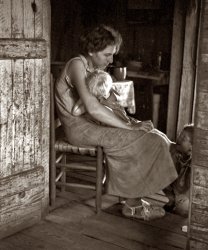
- Seed and Feed: 1935
- ... market sidewalk scene." Large-format nitrate negative by Walker Evans for the FSA. View full size.
Down on Decatur Street Decatur ... Posted by Dave - 09/05/2012 - 6:05pm -
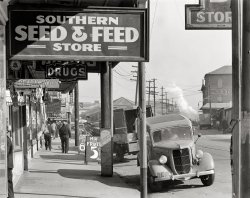
- O.K. Soap: 1936
- ... the general store in Moundville, Alabama. Photographed by Walker Evans in the summer of 1936. Top shelf inventory: 1 box Peter Loaded Shells, 2 ... Posted by Ken - 08/08/2012 - 12:28pm -
